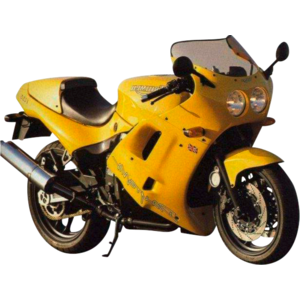Triumph Daytona 1200 (1993-1997): The British Superbike That Redefined Comfort and Speed
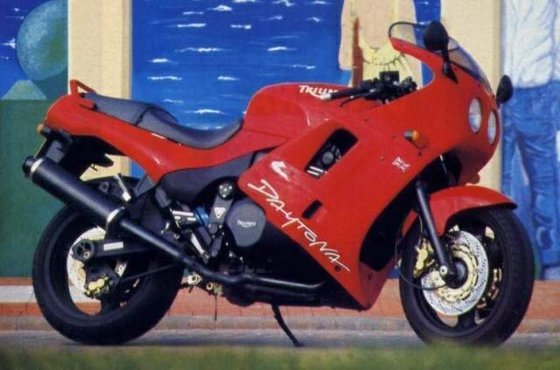
Introduction
When Triumph reemerged in the 1990s after decades of silence, it didn’t just return to the motorcycle market—it stormed back with a statement. The Daytona 1200, produced from 1993 to 1997, was that statement. This wasn’t just another sportbike; it was a machine that challenged Japanese dominance by blending raw power with unexpected comfort. Even today, riding a well-preserved Daytona 1200 feels like straddling a piece of history—one that still holds its own against modern expectations. Let’s dive into what makes this British icon unforgettable.
Design & Ergonomics: A Sportbike You Could Live With
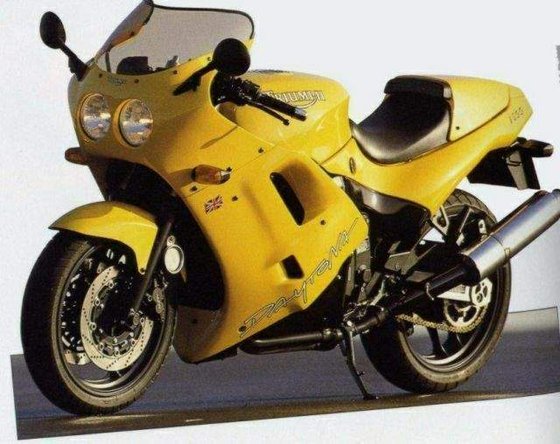
The Daytona 1200’s design screams early-’90s ambition. Its swooping fairing, angular lines, and bold color schemes (think Triumph’s signature Carnival Red or Glacier White) give it a presence that’s equal parts aggressive and elegant. Unlike the cramped, race-focused ergonomics of its rivals, the Daytona opts for a surprisingly relaxed riding position. The handlebars sit higher than typical sportbikes of the era, and the footpegs are positioned low enough to avoid knee strain. At 790 mm (31.1 inches), the seat height is accessible for most riders, though the bike’s 250 kg (551 lbs) wet weight becomes apparent when maneuvering at parking-lot speeds.
The fairing deserves special praise. Triumph’s wind tunnel work paid off—even at triple-digit speeds, wind blast is minimal. The screen directs airflow over the rider’s helmet, reducing fatigue on long hauls. Compared to the buzzy, cramped cockpits of bikes like the Suzuki GSX-R1100, the Daytona feels almost luxurious.
Engine & Performance: A Gentle Giant With a Ferocious Streak
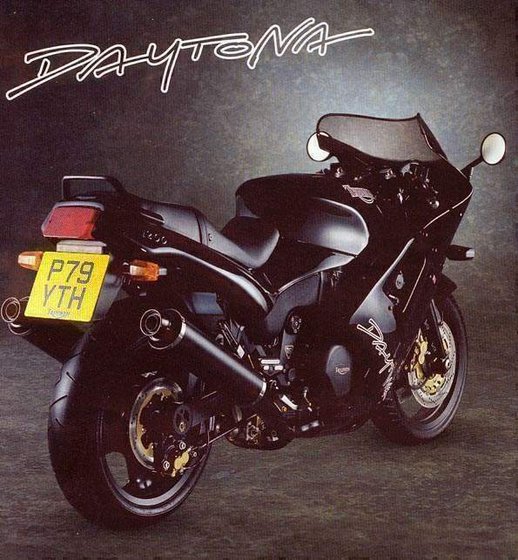
At the heart of the Daytona 1200 lies its 1,180 cc liquid-cooled inline-four engine—a masterpiece of British engineering. With 147 hp (107 kW) at the crank (118 hp at the rear wheel) and 115 Nm (84.8 lb-ft) of torque, this engine isn’t just powerful; it’s charismatic. Thumb the starter, and the four-cylinder awakens with a deep, metallic growl that smooths into a turbine-like whine as the revs climb.
What sets the Daytona apart is its delivery. While Japanese liter bikes of the ’90s demanded high revs to unlock their potential, the Triumph’s torque curve is meaty and accessible. From 4,000 rpm onward, it pulls with relentless urgency, hitting 100 km/h (62 mph) in 3.2 seconds and devouring highway overtakes in any gear. The 6-speed transmission is slick, though the clutch requires a firm hand in stop-and-go traffic.
Fuel economy? Expect around 5.6 L/100 km (41.6 US mpg) if you’re gentle—but let’s be honest, you won’t be. This engine begs to be ridden hard, and it’s built to handle it. The liquid cooling system keeps temps stable even when pushing through summer traffic, and the 25-liter (6.6-gallon) fuel tank means fewer stops on long rides.
Handling & Ride Quality: Stability Over Sharpness
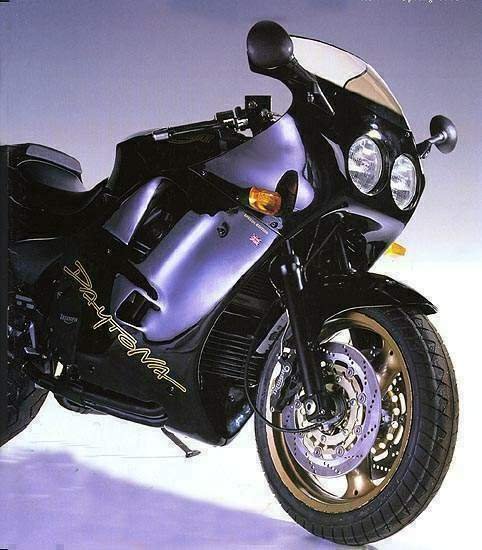
Weighing 250 kg (551 lbs) wet, the Daytona 1200 isn’t a featherweight. But Triumph turned this into a strength. The chassis, shared with the touring-oriented Trophy 1200, prioritizes stability. On sweeping bends and high-speed straights, the bike feels planted, almost unshakable. The 43 mm Kayaba forks and monoshock rear suspension (both adjustable for preload and damping) strike a balance between sporty responsiveness and compliance. Over rough roads, the Daytona soaks up bumps better than the harshly sprung Kawasaki ZZ-R1100.
Push it hard into tight corners, and the weight does show. The bike prefers flowing lines to abrupt direction changes, and the 180/55-ZR17 rear tire, wide for its time, requires deliberate countersteering. Ground clearance is decent, but enthusiastic riders will scrape peels and exhausts long before losing traction.
Braking is a highlight. Dual 310 mm front discs with 4-piston Nissen calipers provide strong, fade-resistant stopping power. From 100 km/h (62 mph), the Daytona halts in 38 meters (125 ft)—a figure that still impresses today.
Competition: How the Daytona Stood Out
In the ’90s superbike arena, the Daytona 1200 faced fierce rivals:
- Kawasaki ZZ-R1100: The speed king, with a 160+ mph top speed. But its ultra-sporty ergonomics and peaky engine made it exhausting for anything but short blasts.
- Suzuki GSX-R1100: Lighter and sharper, but notorious for punishing ride quality and finicky carburetors.
- Honda CBR1000F: More touring-focused, but down on power (98 hp) and excitement.
The Daytona carved its niche by being the rider’s choice. It wasn’t the fastest in a straight line (though 256 km/h / 159 mph is no joke), nor the most agile. But its blend of power, comfort, and stability made it uniquely versatile. Touring riders appreciated the relaxed ergonomics, while sport riders loved the accessible torque. It was a bike you could ride across a continent one day and carve canyons the next—something its rivals couldn’t match.
Maintenance: Keeping the Legend Alive
Owning a Daytona 1200 today requires attention to a few key areas:
- Valve Adjustments
- Intake valves: 0.10–0.15 mm (0.004–0.006 in) cold
-
Exhaust valves: 0.15–0.20 mm (0.006–0.008 in) cold
Check every 12,000 km (7,500 miles). Sticking valves can lead to poor idling—a common issue if neglected. -
Carburetor Tuning
The 36 mm flat-side carbs are reliable but sensitive to ethanol-blended fuels. Use a stabilizer and clean them annually. The air screw baseline is 2 turns out. -
Oil & Fluids
- Engine oil: 3.5 liters (3.7 quarts) of synthetic 10W-30. The wet clutch thrives on quality oil.
- Coolant: 3 liters (3.2 quarts) of ethylene glycol mix. Check for leaks around the water pump.
-
Brake fluid: DOT 4. Replace every two years to prevent spongy lever feel.
-
Chain & Sprockets
The 110-link chain and 18/43 sprocket combo wears quickly if not lubricated regularly. Opt for an X-ring chain for longer life. -
Tire Pressures
- Front: 2.5 bar (36 psi)
-
Rear: 2.9 bar (42 psi)
Sticking to these ensures optimal grip and tire longevity. -
Electrical System
The digital ignition is robust, but aged wiring harnesses can develop cracks. Inspect connectors annually for corrosion.
For parts, MOTOPARTS.store stocks everything from NGK DPR8EIX-9 iridium plugs (a worthwhile upgrade) to OEM-spec brake pads.
Conclusion: A Timeless All-Rounder
The Triumph Daytona 1200 isn’t just a relic—it’s a reminder that power and practicality can coexist. Its engine remains a masterpiece, its comfort unmatched in the superbike class, and its styling still turns heads. While modern bikes outclass it in tech and weight savings, few deliver the same visceral thrill and day-long rideability.
If you’re lucky enough to own one, cherish it. And if you’re looking to enhance yours, MOTOPARTS.store has the expertise and parts to keep your Daytona dominating roads, not just nostalgia lists.
Specifications sheet
| Engine | |
|---|---|
| Stroke: | Four-stroke |
| Ignition: | Digital inductive type |
| Max power: | 107 kW | 143.0 hp |
| Max torque: | 115 Nm |
| Fuel system: | 4 x 36 mm flat side carburetors |
| Max power @: | 9500 rpm |
| Displacement: | 1180 ccm |
| Max torque @: | 8000 rpm |
| Configuration: | Inline |
| Cooling system: | Liquid cooled |
| Starting system: | Electric |
| Compression ratio: | 12:1 |
| Number of cylinders: | 4 |
| Dimensions | |
|---|---|
| Dry weight: | 228 |
| Wet weight: | 250 |
| Seat height: | 790 mm (31.1 in) |
| Fuel tank capacity: | 25 L (6.6 US gal) |
| Drivetrain | |
|---|---|
| Final drive: | chain |
| Chain length: | 110 |
| Transmission: | 6-speed |
| Rear sprocket: | 43 |
| Front sprocket: | 18 |
| Maintenance | |
|---|---|
| Engine oil: | SAE 5W-30/10W-30 |
| Idle speed: | 1000 ±50 rpm |
| Brake fluid: | DOT 4 |
| Spark plugs: | NGK DPR8EA-9 or NGK DPR8EIX-9 |
| Spark plug gap: | 0.9 |
| Coolant capacity: | 3.0 |
| Forks oil capacity: | 0.952 |
| Engine oil capacity: | 3.5 |
| Valve clearance (intake, cold): | 0.10–0.15 mm |
| Valve clearance (exhaust, cold): | 0.15–0.20 mm |
| Recommended tire pressure (rear): | 2.9 bar (42 psi) |
| Recommended tire pressure (front): | 2.5 bar (36 psi) |
| Performance | |
|---|---|
| Top speed: | 256 km/h (159 mph) |
| Standing ¼ mile: | 10.9 sec @ 202.6 km/h (126 mph) |
| Chassis and Suspension | |
|---|---|
| Rear tire: | 180/55-z-17 |
| Front tire: | 120/70-z-17 |
| Rear brakes: | Single 255 mm disc, 2-piston Nissen caliper |
| Front brakes: | 2 x 310 mm discs, 4-piston Nissen calipers |
| Rear suspension: | Monoshock (Kayaba), adjustable preload and rebound damping |
| Front suspension: | 43 mm telescopic forks (Kayaba), triple-rate springs, adjustable compression, rebound damping, and preload |



